service schedule DODGE GRAND CARAVAN 2009 5.G Owners Manual
[x] Cancel search | Manufacturer: DODGE, Model Year: 2009, Model line: GRAND CARAVAN, Model: DODGE GRAND CARAVAN 2009 5.GPages: 535, PDF Size: 18.61 MB
Page 261 of 535
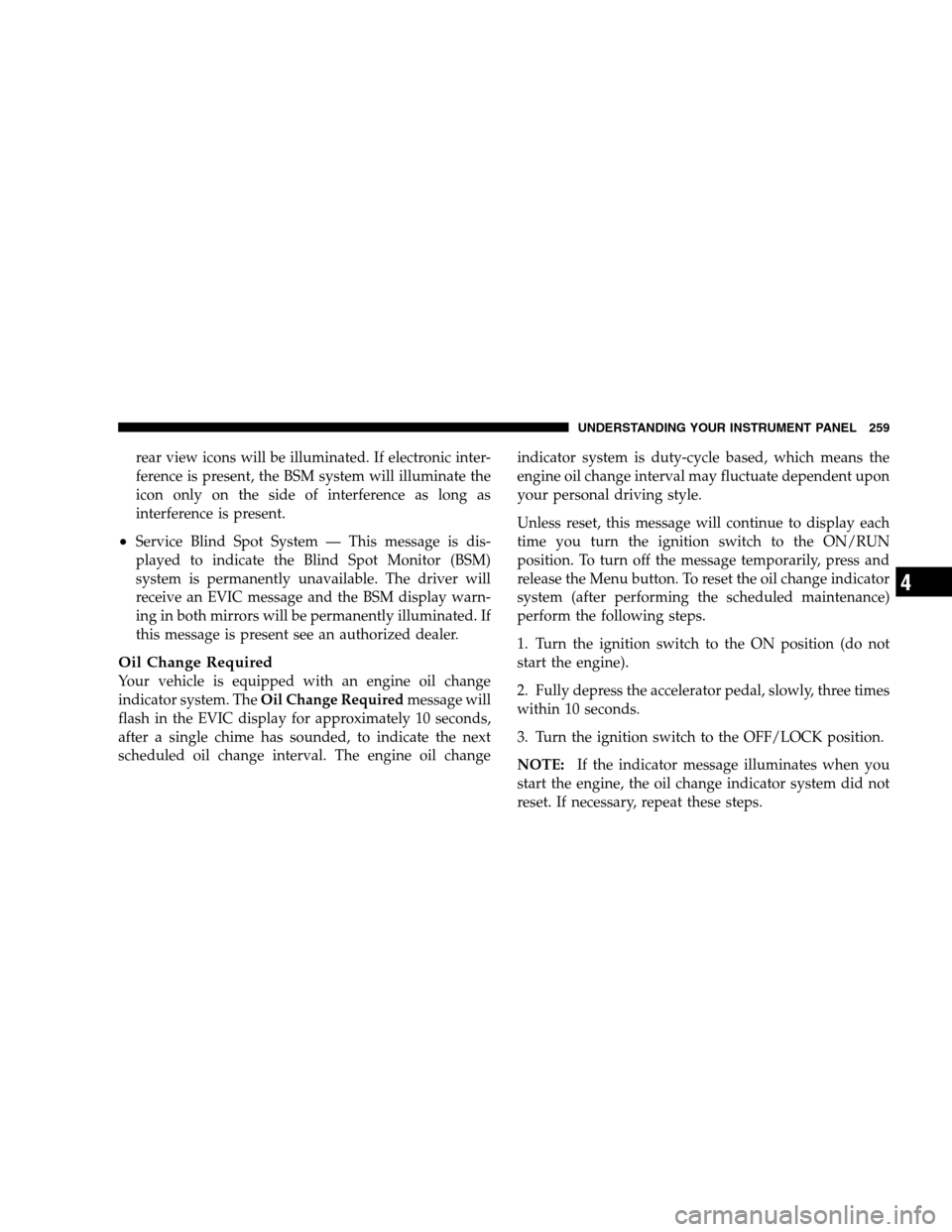
rear view icons will be illuminated. If electronic inter-
ference is present, the BSM system will illuminate the
icon only on the side of interference as long as
interference is present.
Service Blind Spot System — This message is dis-
played to indicate the Blind Spot Monitor (BSM)
system is permanently unavailable. The driver will
receive an EVIC message and the BSM display warn-
ing in both mirrors will be permanently illuminated. If
this message is present see an authorized dealer.
Oil Change Required
Your vehicle is equipped with an engine oil change
indicator system. TheOil Change Required message will
flash in the EVIC display for approximately 10 seconds,
after a single chime has sounded, to indicate the next
scheduled oil change interval. The engine oil change indicator system is duty-cycle based, which means the
engine oil change interval may fluctuate dependent upon
your personal driving style.
Unless reset, this message will continue to display each
time you turn the ignition switch to the ON/RUN
position. To turn off the message temporarily, press and
release the Menu button. To reset the oil change indicator
system (after performing the scheduled maintenance)
perform the following steps.
1. Turn the ignition switch to the ON position (do not
start the engine).
2. Fully depress the accelerator pedal, slowly, three times
within 10 seconds.
3. Turn the ignition switch to the OFF/LOCK position.
NOTE:
If the indicator message illuminates when you
start the engine, the oil change indicator system did not
reset. If necessary, repeat these steps.
UNDERSTANDING YOUR INSTRUMENT PANEL 259 4
Page 335 of 535
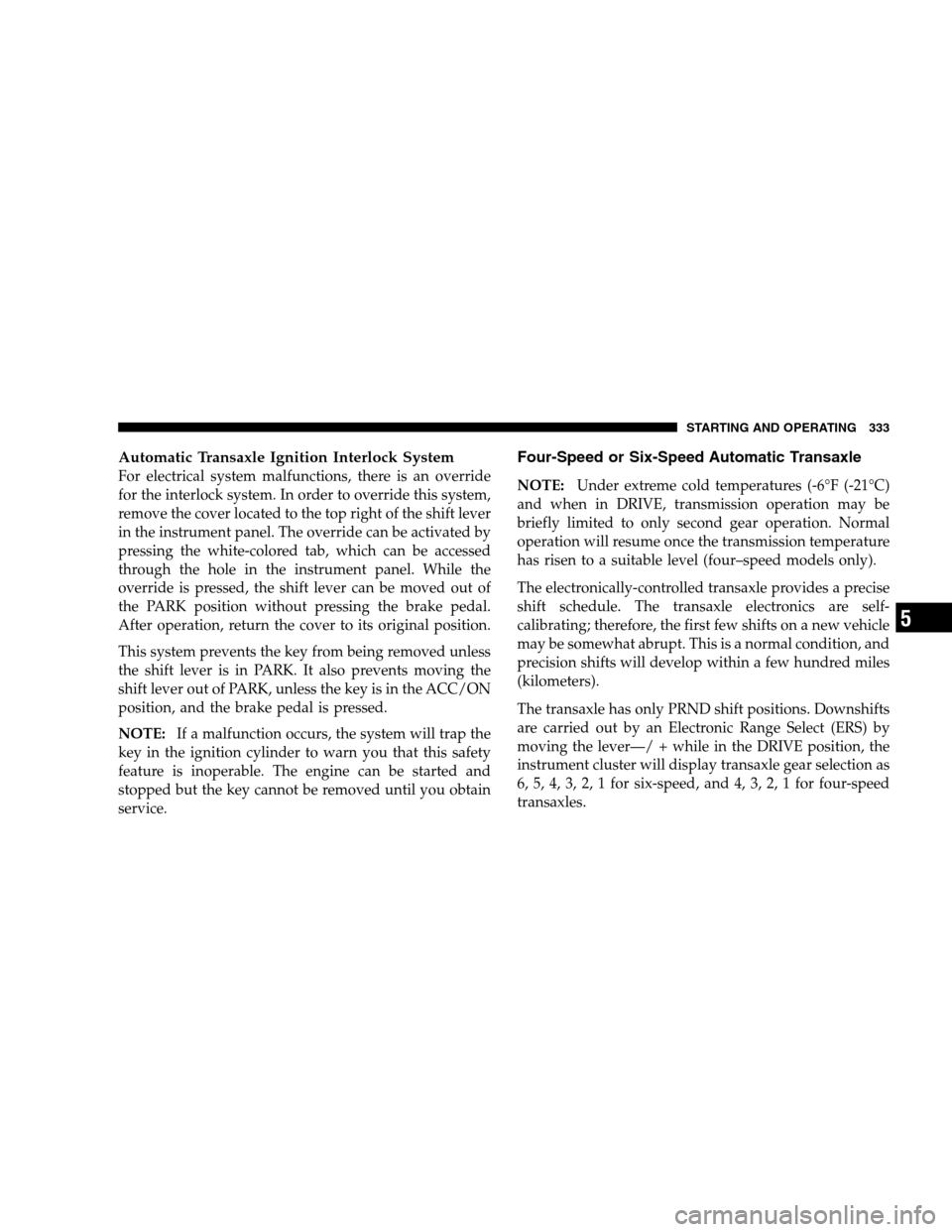
Automatic Transaxle Ignition Interlock SystemFor electrical system malfunctions, there is an override
for the interlock system. In order to override this system,
remove the cover located to the top right of the shift lever
in the instrument panel. The override can be activated by
pressing the white-colored tab, which can be accessed
through the hole in the instrument panel. While the
override is pressed, the shift lever can be moved out of
the PARK position without pressing the brake pedal.
After operation, return the cover to its original position.
This system prevents the key from being removed unless
the shift lever is in PARK. It also prevents moving the
shift lever out of PARK, unless the key is in the ACC/ON
position, and the brake pedal is pressed.
NOTE:
If a malfunction occurs, the system will trap the
key in the ignition cylinder to warn you that this safety
feature is inoperable. The engine can be started and
stopped but the key cannot be removed until you obtain
service.
Four-Speed or Six-Speed Automatic Transaxle
NOTE: Under extreme cold temperatures (-6°F (-21°C)
and when in DRIVE, transmission operation may be
briefly limited to only second gear operation. Normal
operation will resume once the transmission temperature
has risen to a suitable level (four–speed models only).
The electronically-controlled transaxle provides a precise
shift schedule. The transaxle electronics are self-
calibrating; therefore, the first few shifts on a new vehicle
may be somewhat abrupt. This is a normal condition, and
precision shifts will develop within a few hundred miles
(kilometers).
The transaxle has only PRND shift positions. Downshifts
are carried out by an Electronic Range Select (ERS) by
moving the lever—/ + while in the DRIVE position, the
instrument cluster will display transaxle gear selection as
6, 5, 4, 3, 2, 1 for six-speed, and 4, 3, 2, 1 for four-speed
transaxles.
STARTING AND OPERATING 333 5
Page 388 of 535
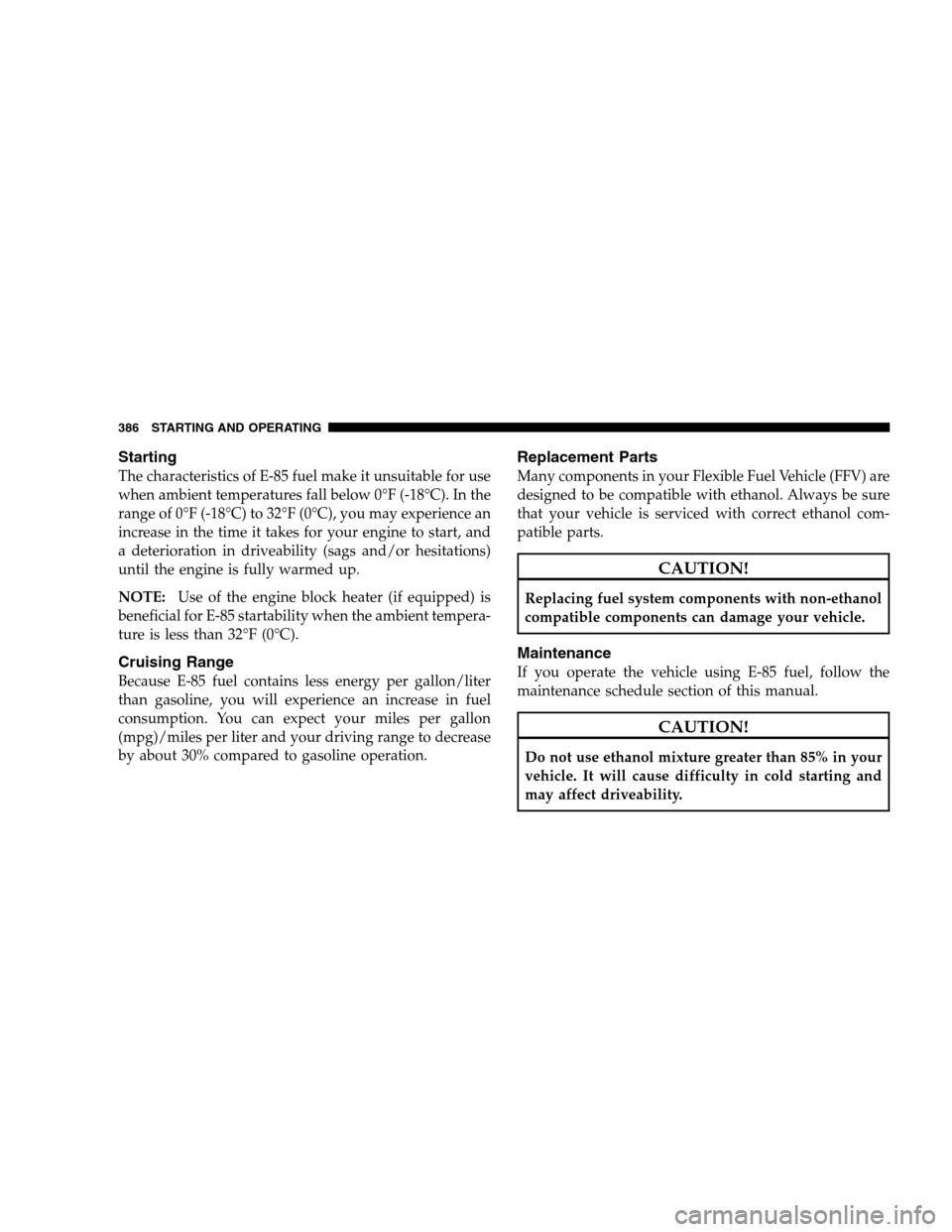
StartingThe characteristics of E-85 fuel make it unsuitable for use
when ambient temperatures fall below 0°F (-18°C). In the
range of 0°F (-18°C) to 32°F (0°C), you may experience an
increase in the time it takes for your engine to start, and
a deterioration in driveability (sags and/or hesitations)
until the engine is fully warmed up.
NOTE:
Use of the engine block heater (if equipped) is
beneficial for E-85 startability when the ambient tempera-
ture is less than 32°F (0°C).
Cruising Range
Because E-85 fuel contains less energy per gallon/liter
than gasoline, you will experience an increase in fuel
consumption. You can expect your miles per gallon
(mpg)/miles per liter and your driving range to decrease
by about 30% compared to gasoline operation.
Replacement Parts
Many components in your Flexible Fuel Vehicle (FFV) are
designed to be compatible with ethanol. Always be sure
that your vehicle is serviced with correct ethanol com-
patible parts. CAUTION!
Replacing fuel system components with non-ethanol
compatible components can damage your vehicle.
Maintenance
If you operate the vehicle using E-85 fuel, follow the
maintenance schedule section of this manual.
CAUTION!
Do not use ethanol mixture greater than 85% in your
vehicle. It will cause difficulty in cold starting and
may affect driveability.
386 STARTING AND OPERATING
Page 439 of 535
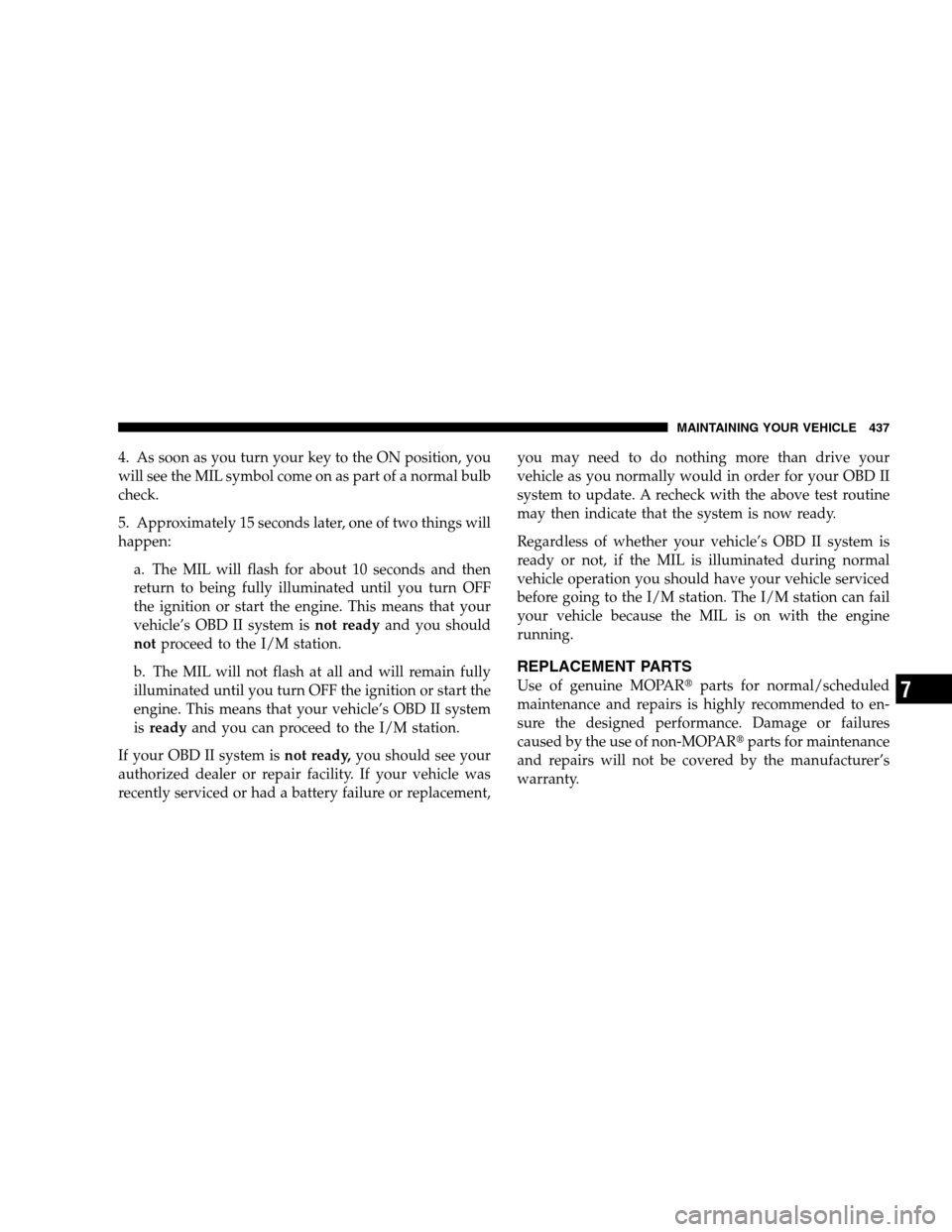
4. As soon as you turn your key to the ON position, you
will see the MIL symbol come on as part of a normal bulb
check.
5. Approximately 15 seconds later, one of two things will
happen:a. The MIL will flash for about 10 seconds and then
return to being fully illuminated until you turn OFF
the ignition or start the engine. This means that your
vehicle’s OBD II system is not readyand you should
not proceed to the I/M station.
b. The MIL will not flash at all and will remain fully
illuminated until you turn OFF the ignition or start the
engine. This means that your vehicle’s OBD II system
is ready and you can proceed to the I/M station.
If your OBD II system is not ready,you should see your
authorized dealer or repair facility. If your vehicle was
recently serviced or had a battery failure or replacement, you may need to do nothing more than drive your
vehicle as you normally would in order for your OBD II
system to update. A recheck with the above test routine
may then indicate that the system is now ready.
Regardless of whether your vehicle’s OBD II system is
ready or not, if the MIL is illuminated during normal
vehicle operation you should have your vehicle serviced
before going to the I/M station. The I/M station can fail
your vehicle because the MIL is on with the engine
running.
REPLACEMENT PARTS
Use of genuine MOPARt
parts for normal/scheduled
maintenance and repairs is highly recommended to en-
sure the designed performance. Damage or failures
caused by the use of non-MOPARt parts for maintenance
and repairs will not be covered by the manufacturer’s
warranty.
MAINTAINING YOUR VEHICLE 437 7
Page 444 of 535
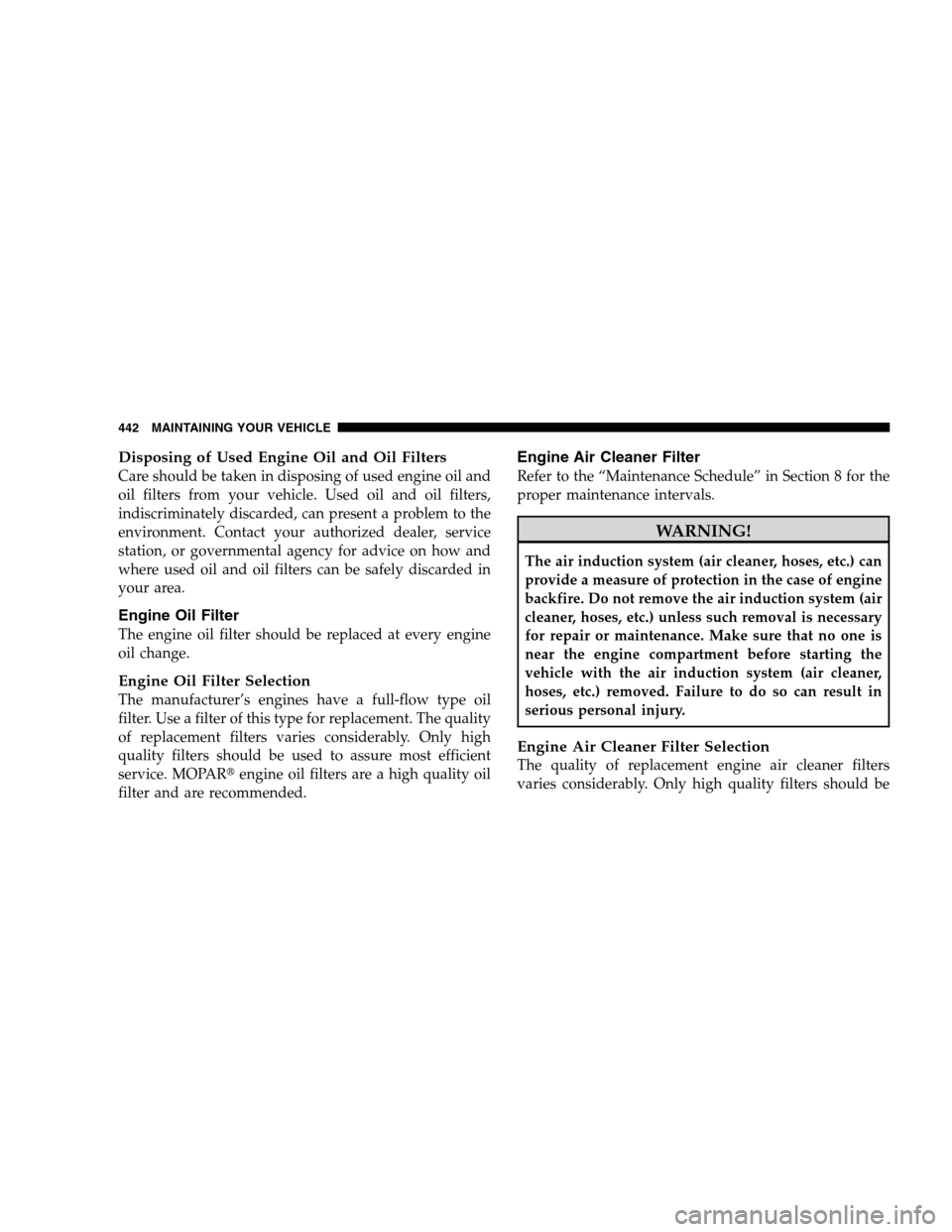
Disposing of Used Engine Oil and Oil FiltersCare should be taken in disposing of used engine oil and
oil filters from your vehicle. Used oil and oil filters,
indiscriminately discarded, can present a problem to the
environment. Contact your authorized dealer, service
station, or governmental agency for advice on how and
where used oil and oil filters can be safely discarded in
your area.
Engine Oil Filter
The engine oil filter should be replaced at every engine
oil change.
Engine Oil Filter Selection
The manufacturer’s engines have a full-flow type oil
filter. Use a filter of this type for replacement. The quality
of replacement filters varies considerably. Only high
quality filters should be used to assure most efficient
service. MOPARt
engine oil filters are a high quality oil
filter and are recommended.
Engine Air Cleaner Filter
Refer to the “Maintenance Schedule” in Section 8 for the
proper maintenance intervals. WARNING!
The air induction system (air cleaner, hoses, etc.) can
provide a measure of protection in the case of engine
backfire. Do not remove the air induction system (air
cleaner, hoses, etc.) unless such removal is necessary
for repair or maintenance. Make sure that no one is
near the engine compartment before starting the
vehicle with the air induction system (air cleaner,
hoses, etc.) removed. Failure to do so can result in
serious personal injury.
Engine Air Cleaner Filter Selection
The quality of replacement engine air cleaner filters
varies considerably. Only high quality filters should be
442 MAINTAINING YOUR VEHICLE
Page 486 of 535
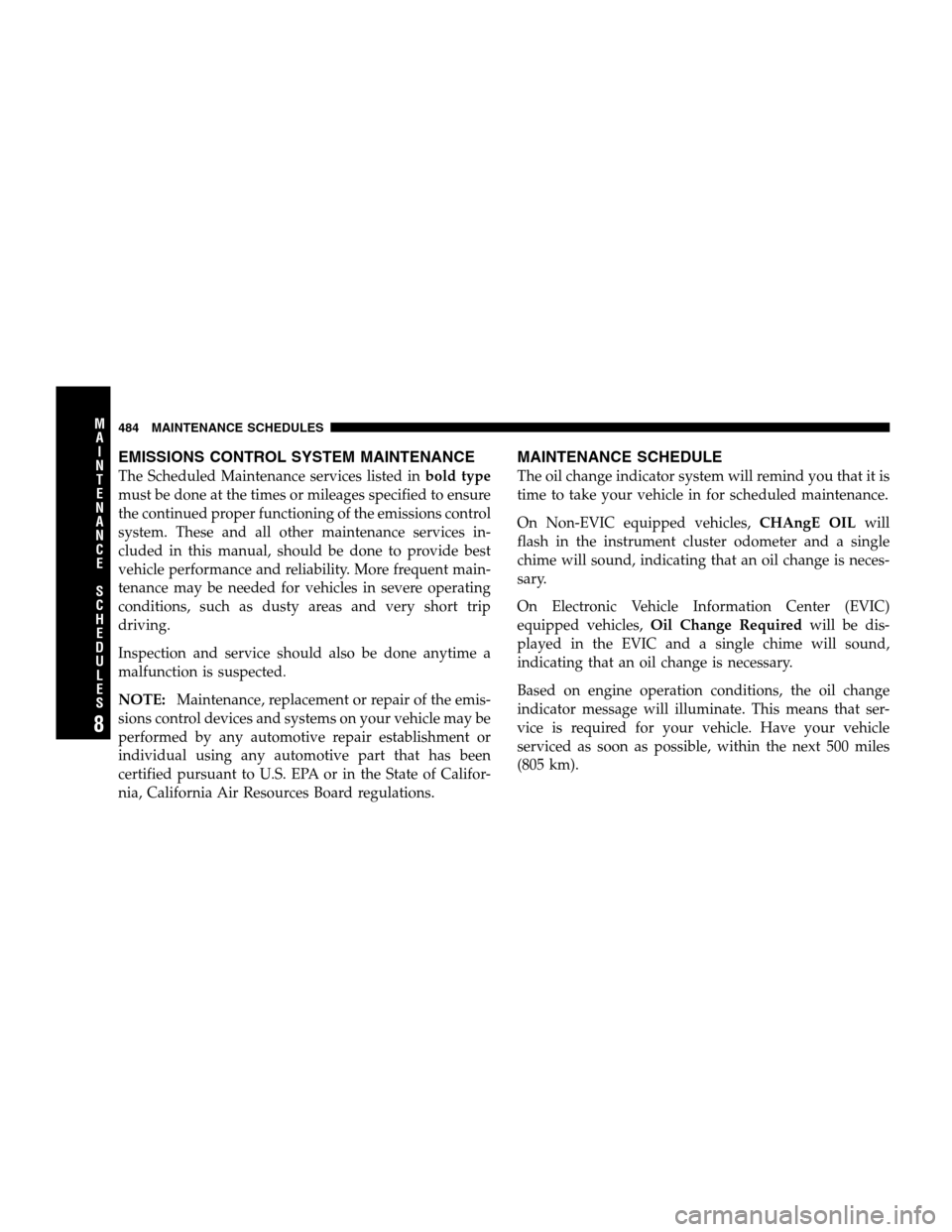
EMISSIONS CONTROL SYSTEM MAINTENANCEThe Scheduled Maintenance services listed in
bold type
must be done at the times or mileages specified to ensure
the continued proper functioning of the emissions control
system. These and all other maintenance services in-
cluded in this manual, should be done to provide best
vehicle performance and reliability. More frequent main-
tenance may be needed for vehicles in severe operating
conditions, such as dusty areas and very short trip
driving.
Inspection and service should also be done anytime a
malfunction is suspected.
NOTE: Maintenance, replacement or repair of the emis-
sions control devices and systems on your vehicle may be
performed by any automotive repair establishment or
individual using any automotive part that has been
certified pursuant to U.S. EPA or in the State of Califor-
nia, California Air Resources Board regulations.
MAINTENANCE SCHEDULE
The oil change indicator system will remind you that it is
time to take your vehicle in for scheduled maintenance.
On Non-EVIC equipped vehicles, CHAngE OILwill
flash in the instrument cluster odometer and a single
chime will sound, indicating that an oil change is neces-
sary.
On Electronic Vehicle Information Center (EVIC)
equipped vehicles, Oil Change Required will be dis-
played in the EVIC and a single chime will sound,
indicating that an oil change is necessary.
Based on engine operation conditions, the oil change
indicator message will illuminate. This means that ser-
vice is required for your vehicle. Have your vehicle
serviced as soon as possible, within the next 500 miles
(805 km).
484 MAINTENANCE SCHEDULES 8
M
A I
N T
E
N A
N C E
S
C
H E
D
U L
E
S
Page 489 of 535
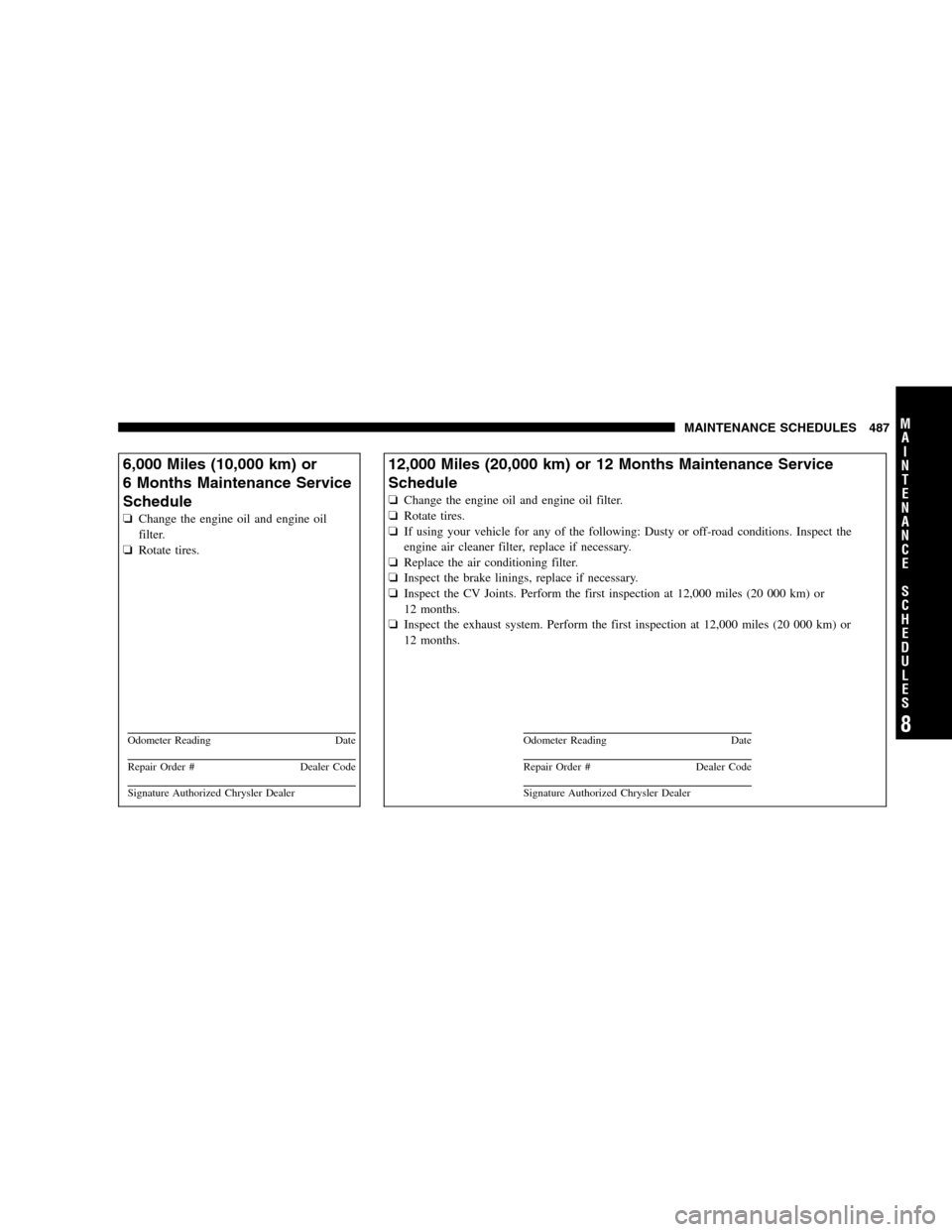
6,000 Miles (10,000 km) or
6 Months
Maintenance Service
Schedule
� Change the engine oil and engine oil
filter.
� Rotate tires. Odometer Reading
DateRepair Order #
Dealer CodeSignature Authorized Chrysler Dealer 12,000 Miles (20,000 km) or 12 Months Maintenance Service
Schedule
�
Change the
engine oil and engine oil filter.
� Rotate tires.
� If using your vehicle for any of the following: Dusty or off-road conditions. Inspect the
engine air cleaner filter, replace if necessary.
� Replace the air conditioning filter.
� Inspect the brake linings, replace if necessary.
� Inspect the CV Joints. Perform the first inspection at 12,000 miles (20 000 km) or
12 months.
� Inspect the exhaust system. Perform the first inspection at 12,000 miles (20 000 km) or
12 months. Odometer Reading
Date Repair Order #
Dealer Code Signature Authorized Chrysler Dealer MAINTENANCE SCHEDULES 487
8
M
A I
N T
E
N A
N C E
S
C
H E
D
U L
E
S
Page 490 of 535
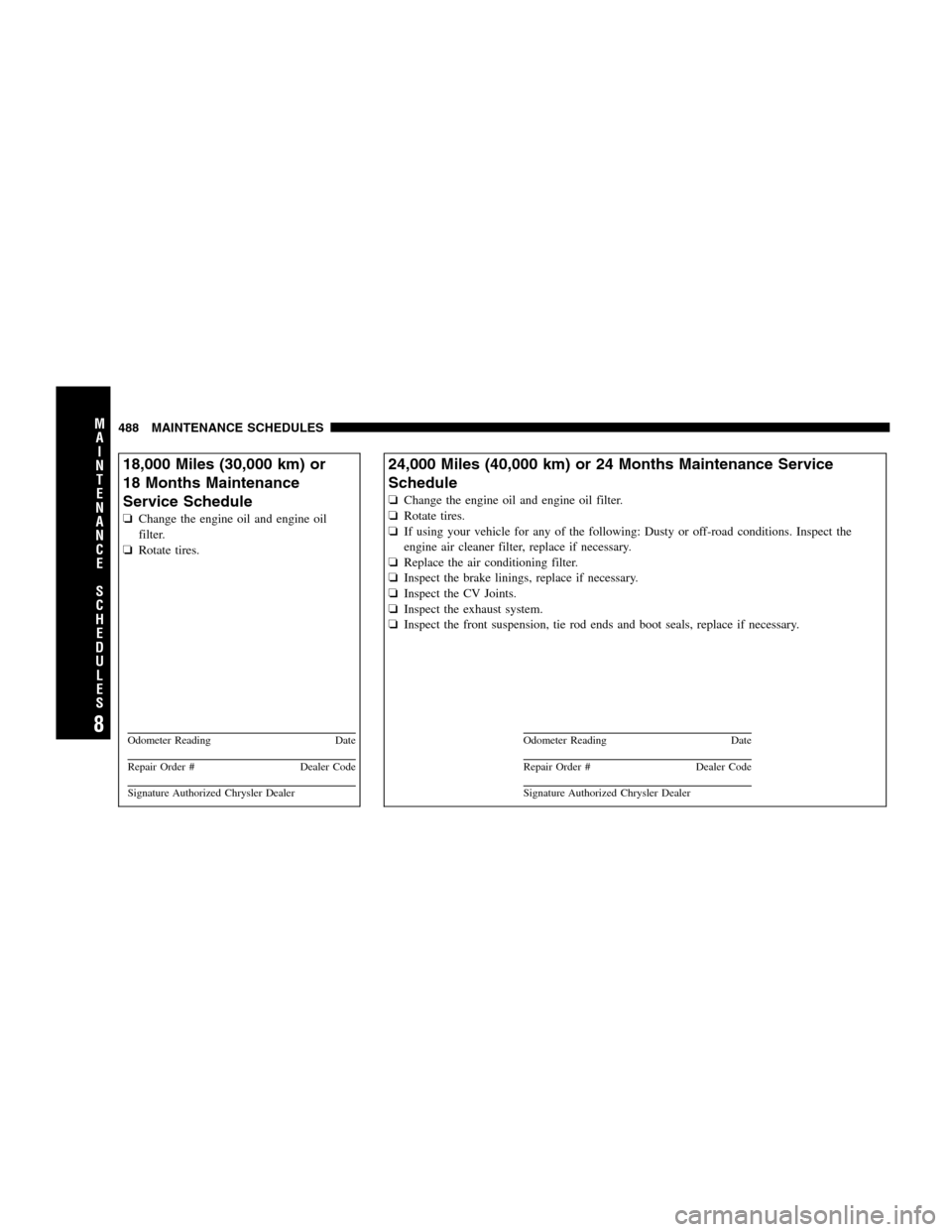
18,000 Miles (30,000 km) or
18 Months
Maintenance
Service Schedule
� Change the engine oil and engine oil
filter.
� Rotate tires. Odometer Reading
DateRepair Order #
Dealer CodeSignature Authorized Chrysler Dealer 24,000 Miles (40,000 km) or 24 Months Maintenance Service
Schedule
�
Change the
engine oil and engine oil filter.
� Rotate tires.
� If using your vehicle for any of the following: Dusty or off-road conditions. Inspect the
engine air cleaner filter, replace if necessary.
� Replace the air conditioning filter.
� Inspect the brake linings, replace if necessary.
� Inspect the CV Joints.
� Inspect the exhaust system.
� Inspect the front suspension, tie rod ends and boot seals, replace if necessary. Odometer Reading
Date Repair Order #
Dealer Code Signature Authorized Chrysler Dealer488 MAINTENANCE SCHEDULES
8
M
A I
N T
E
N A
N C E
S
C
H E
D
U L
E
S
Page 491 of 535
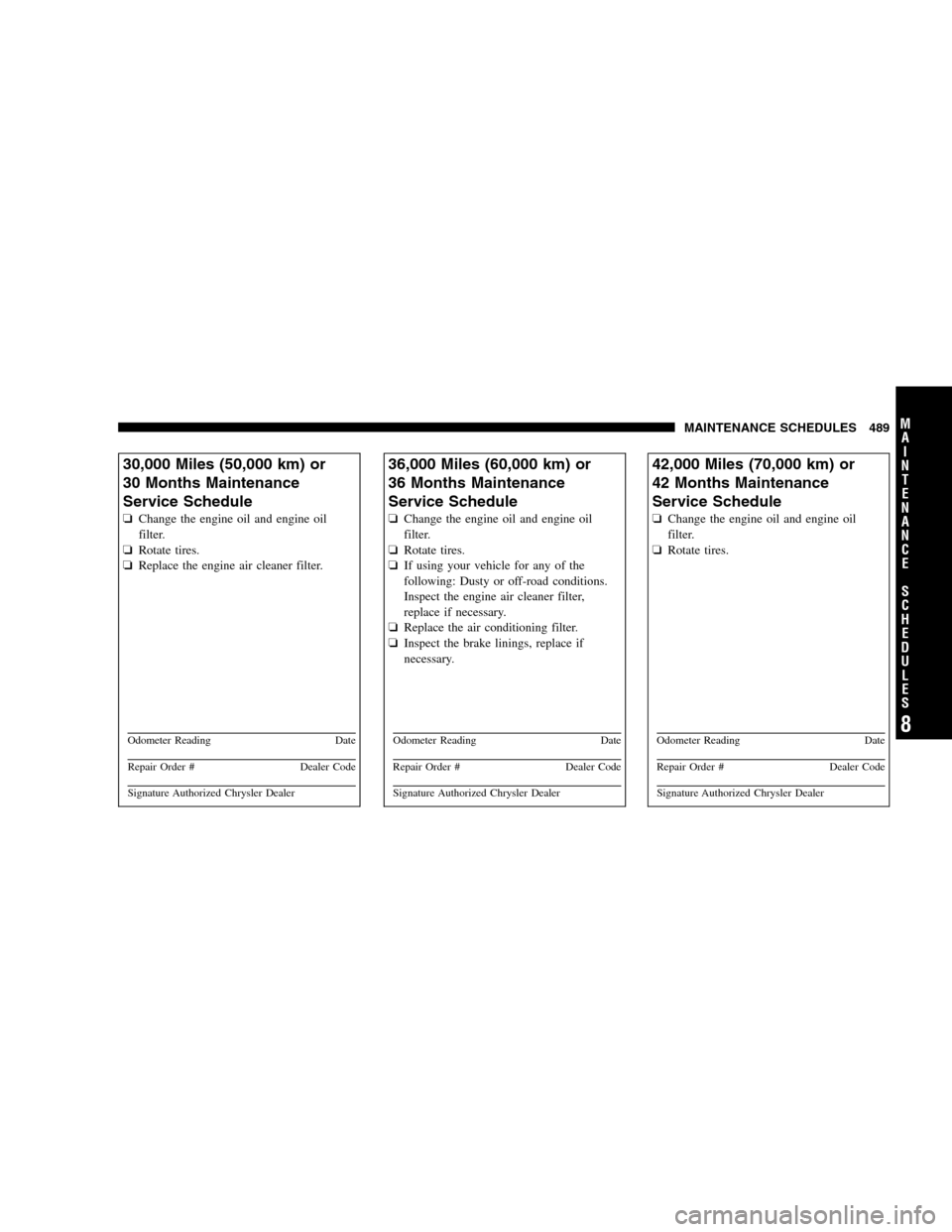
30,000 Miles (50,000 km) or
30 Months
Maintenance
Service Schedule
� Change the engine oil and engine oil
filter.
� Rotate tires.
� Replace the engine air cleaner filter. Odometer Reading
DateRepair Order #
Dealer CodeSignature Authorized Chrysler Dealer 36,000 Miles (60,000 km) or
36 Months
Maintenance
Service Schedule
� Change the engine oil and engine oil
filter.
� Rotate tires.
� If using your vehicle for any of the
following: Dusty or off-road conditions.
Inspect the engine air cleaner filter,
replace if necessary.
� Replace the air conditioning filter.
� Inspect the brake linings, replace if
necessary. Odometer Reading
Date Repair Order #
Dealer Code Signature Authorized Chrysler Dealer 42,000 Miles (70,000 km) or
42 Months
Maintenance
Service Schedule
� Change the engine oil and engine oil
filter.
� Rotate tires. Odometer Reading
Date Repair Order #
Dealer Code Signature Authorized Chrysler Dealer MAINTENANCE SCHEDULES 489
8
M
A I
N T
E
N A
N C E
S
C
H E
D
U L
E
S
Page 492 of 535
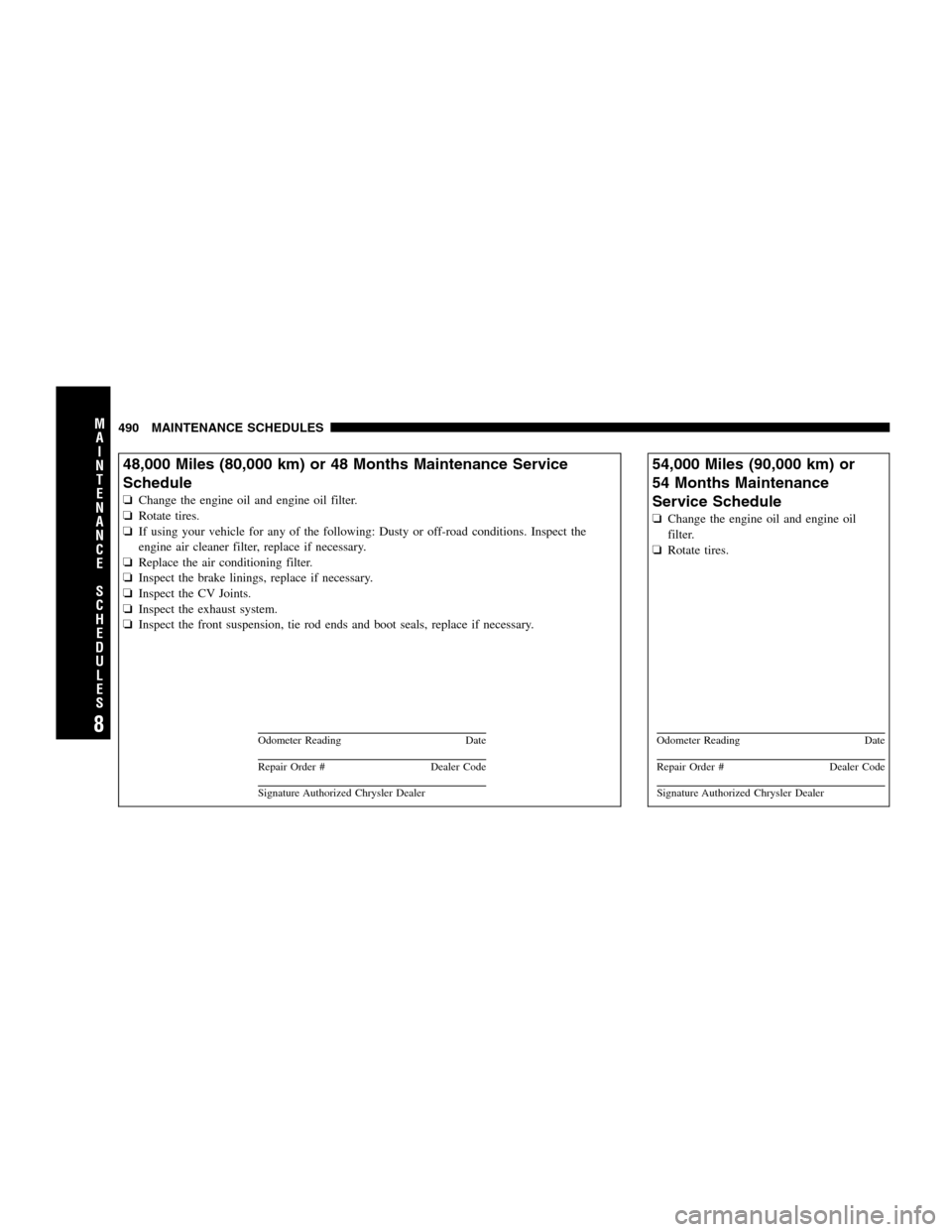
48,000 Miles (80,000 km) or 48 Months Maintenance Service
Schedule
�
Change the
engine oil and engine oil filter.
� Rotate tires.
� If using your vehicle for any of the following: Dusty or off-road conditions. Inspect the
engine air cleaner filter, replace if necessary.
� Replace the air conditioning filter.
� Inspect the brake linings, replace if necessary.
� Inspect the CV Joints.
� Inspect the exhaust system.
� Inspect the front suspension, tie rod ends and boot seals, replace if necessary. Odometer Reading
Date Repair Order #
Dealer Code Signature Authorized Chrysler Dealer 54,000 Miles (90,000 km) or
54 Months
Maintenance
Service Schedule
� Change the engine oil and engine oil
filter.
� Rotate tires. Odometer Reading
Date Repair Order #
Dealer Code Signature Authorized Chrysler Dealer490 MAINTENANCE SCHEDULES
8
M
A I
N T
E
N A
N C E
S
C
H E
D
U L
E
S